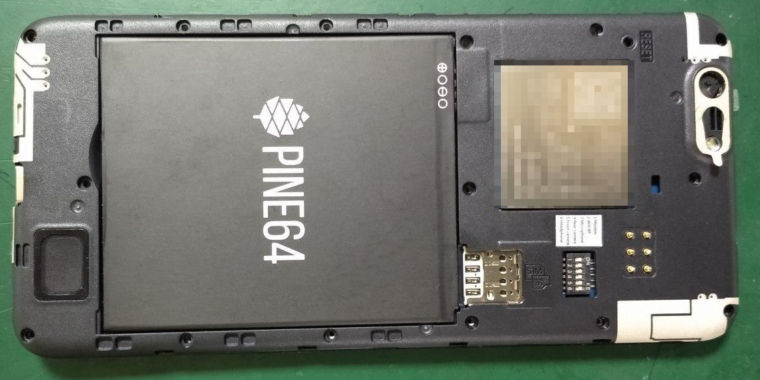
-
The front and back of the PinePhone.
-
This photo has side views.
-
A real picture of the PinePhone in its shipping box.
-
The PinePhone with the back peeled off.
-
Here you can see the six gold pogo pins at the top, along with the six dip switches.
-
A factory full of PinePhones.
-
This crazy adapter will let you debug the PinePhone through the headphone jack.
-
The Psion Series 5mx, which Pine64 wants to use as inspiration for its keyboard case.
-
Just for fun, here's the PineTime.
-
And the PineTab. This is a tablet with a removable keyboard.
Pine64 has announced that it is finally shipping the PinePhone, a smartphone that takes the rare step outside the Android/iOS duopoly and is designed to run mainline Linux distributions. The PinePhone starts shipping January 17 in the "Braveheart" developer edition.
This initial "Braveheart" batch of devices is meant for "developer and early adopter" users, according to the Pine64 Store. The phone doesn't come with an end-user OS pre-installed and, instead, only comes with a factory test image that allows for easy verification that the hardware works. Users are expected to flash their own OS to the device. There are several available, from Ubuntu Touch to Sailfish OS, but they are all currently in an unfinished alpha state. Pine64 says that only enthusiasts with "extensive Linux experience" are the intended customer here—this isn't (yet?) a mainstream product.
It's hard to mention PinePhone without mentioning that other Linux smartphone, the Purism Librem 5. They could both end up running the same software one day, but the two companies are taking totally different approaches to hardware. Purism has a hardline requirement for the hardware: it needs to be as open and freedom-focused as possible, which means the company couldn't use the typical supply chain that exists for Android phones. Purism has only a limited amount of open source-compatible vendors to choose from, and it uses M.2 socketed chips for the closed-source Wi-Fi/Bluetooth and Cell modem. The result is a device that is very thick (16mm), hot, and expensive, at $750. The PinePhone is less averse to binary blobs and is a lot closer to a normal smartphone. It's a more reasonable thickness (9mm) and a more reasonable price: $150.The PinePhone is powered by an Allwinner A64 SoC, which features four Cortex A53 CPUs at 1.2GHz, built on a pretty ancient 40nm process. This is the same chip the company uses on the PINE A64 single board computer, a Raspberry Pi competitor. There are 2GB of RAM, a Mali-400 GPU, 16GB of storage, and a 2750mAh battery. The rear camera is 5MP, the front camera is 2MP, the display is a 1440×720 IPS LCD, and the battery is removable. There's a headphone jack, a USB-C port, and support for a MicroSD slot, which you can actually boot operating systems off of. The cellular modem is a large separate chip that is soldered onto the motherboard: a Quectel EG25-G.
When the back of the phone is peeled off, the innards actually have some special components. Near the top right corner is a 2x3 grid of gold pogo pins that can provide power, I2C, and GPIO to an attached accessory. Pine64 says that a keyboard case attachment is planned for "sometime in 2020," and for now, the company is still working on the design. The company says it is "making a keyboard heavily inspired by Psion Series 5 keyboards from the 1990s. We hope to not only replicated [sic] the usability of the Psion Series 5 keyboard but also the tactile feel it is known for. "
The Psion 5 was a clamshell PDA that ran the EPOC operating system (which was later renamed "Symbian OS") and was powered by 2 AA batteries. Smartphone keyboards from the Moto Droid era would use a single sheet of rubbery keys that squished down onto a contact, but the Psion 5 keyboard was different. The Psion 5 has a scaled-down version of a cheap desktop keyboard, with individual hard, plastic keys that each sat on top of a membrane switch.
Also under the removable back is a set of six dip switches that act as privacy kill switches. Users can kill the Modem/GPS, Wi-Fi/Bluetooth, microphone, rear camera, and front camera. The last one, which isn't a privacy feature, is a switch for the headphone jack. The headphone jack switch toggles from the normal mode of operation to a UART (Universal asynchronous receiver-transmitter) port. With this wild-looking male-3.5mm-to-male-USB-A wire, you can get a serial connection out of the PinePhone and do some debugging.
With the phone shipping, Pine64 isn't resting on its laurels. The company is also working on a "PineTab" Linux tablet with a detachable keyboard and a "PineTime" smart watch. Soon you'll be able to run mainline Linux on everything, provided the software actually gets developed.
Listing image by Pine64
"Smartphone" - Google News
January 17, 2020 at 03:30AM
https://ift.tt/36WzE9o
The PinePhone starts shipping—a Linux-powered smartphone for $150 - Ars Technica
"Smartphone" - Google News
https://ift.tt/2QXWyGT
Shoes Man Tutorial
Pos News Update
Meme Update
Korean Entertainment News
Japan News Update
Bagikan Berita Ini














0 Response to "The PinePhone starts shipping—a Linux-powered smartphone for $150 - Ars Technica"
Post a Comment